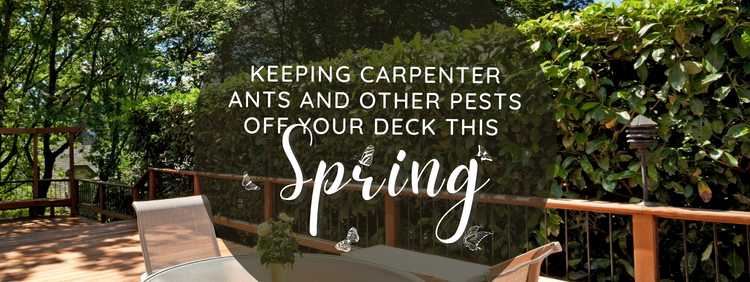Keeping Carpenter Ants and Other Pests Off Your Deck This Spring

Decks are incredible spaces for entertaining or just enjoying the weekend, but they’re vulnerable to a variety of critters. Mice, carpenter bees and carpenter ants can all wreak havoc on wooden structures before you even know they’re there. Fortunately, learning about these pests can help you recognize their presence. According to carpenter ant pest control experts, here’s everything homeowners should know about what attracts animals to decks.
Rats and Mice
Mice and rats see decks as potential nesting spots since they’re out of the weather and close to your home. For rodents, human residences are a goldmine of food, an essential factor for expectant mothers who won’t leave their young for long periods of time.
Of course, your house isn’t the only feature that benefits wild animals — your yard may be what attracts rodents in the first place. Rats and mice are primarily concerned with survival, which means three things:
- Safety
- Food
- Water
As a result, certain features can transform a lawn into a rodent haven. For example, tall grass and overgrown bushes hide mice from owls, hawks and other natural predators. Water features such as bird baths and ponds provide reliable water sources, while unsecured garbage cans, bird feeders and outdoor pet dishes supply steady food. Getting rid of these issues can safeguard your deck — with vigilance, you can avoid needing residential pest control in the first place.
Carpenter Bees
Did you know that not all bees make honey? Unlike their beloved cousins, carpenter bees don’t produce honey or even make traditional hives. Instead, they drill into wood, creating tunnels for egg-laying. This internal damage undermines the wood’s integrity and makes it vulnerable to other issues, such as rot.
The good news is that carpenter bees don’t live in colonies, so you don’t have to worry about thousands of bees making their home in your deck. However, this species revisits old holes, so unaddressed infestations can cause serious damage.
Fortunately, homeowners can prevent a carpenter bee infestation with a few simple measures:
- Treat wood with finish, stains or paint
- Don’t plant flowers near your deck
- Utilizing repellents such as citrus or almond oil
Carpenter Ants
There’s a misconception that carpenter ants eat wood. Rather than consuming wood, these ants chew through it to form tunnels. Their actual food sources are very similar to other ant species:
- Garbage and spills, especially sugary items such as jelly
- Pet food
- Meat
- Insect honeydew
As a result, decks are the perfect place to start a colony, as they provide the necessary wood for shelter and access to lots of human food.
Wet and rotted wood is also attractive to these insects, as it signals moisture nearby. Ants need water like other animals, and even a small leak may be enough to sustain a colony. Since decks are exposed to the weather, it’s essential to prevent water damage by treating the wood. You should also regularly inspect your deck for the following:
- Mildewy smell
- Mould
- Discolouration
- Warping
Additionally, keep your deck as food-free as possible. That means storing garbage cans far away and vacuuming the boards after you eat. These chores can be inconvenient, but they’re less hassle than hiring a carpenter ant removal service and making repairs.
When destructive pests move into your deck, time is of the essence. Calling home pest control as soon as you recognize the signs minimizes damage and saves you money.
Truly Nolen Canada offers comprehensive extermination services to ensure your home is pest-free. That means a thorough inspection to identify the critters, their nests and how they entered your property. With this information, we can form a removal plan and even prevent other pests from moving in. If you have concerns about animals in your deck, schedule an appointment by going online or giving our team a call!